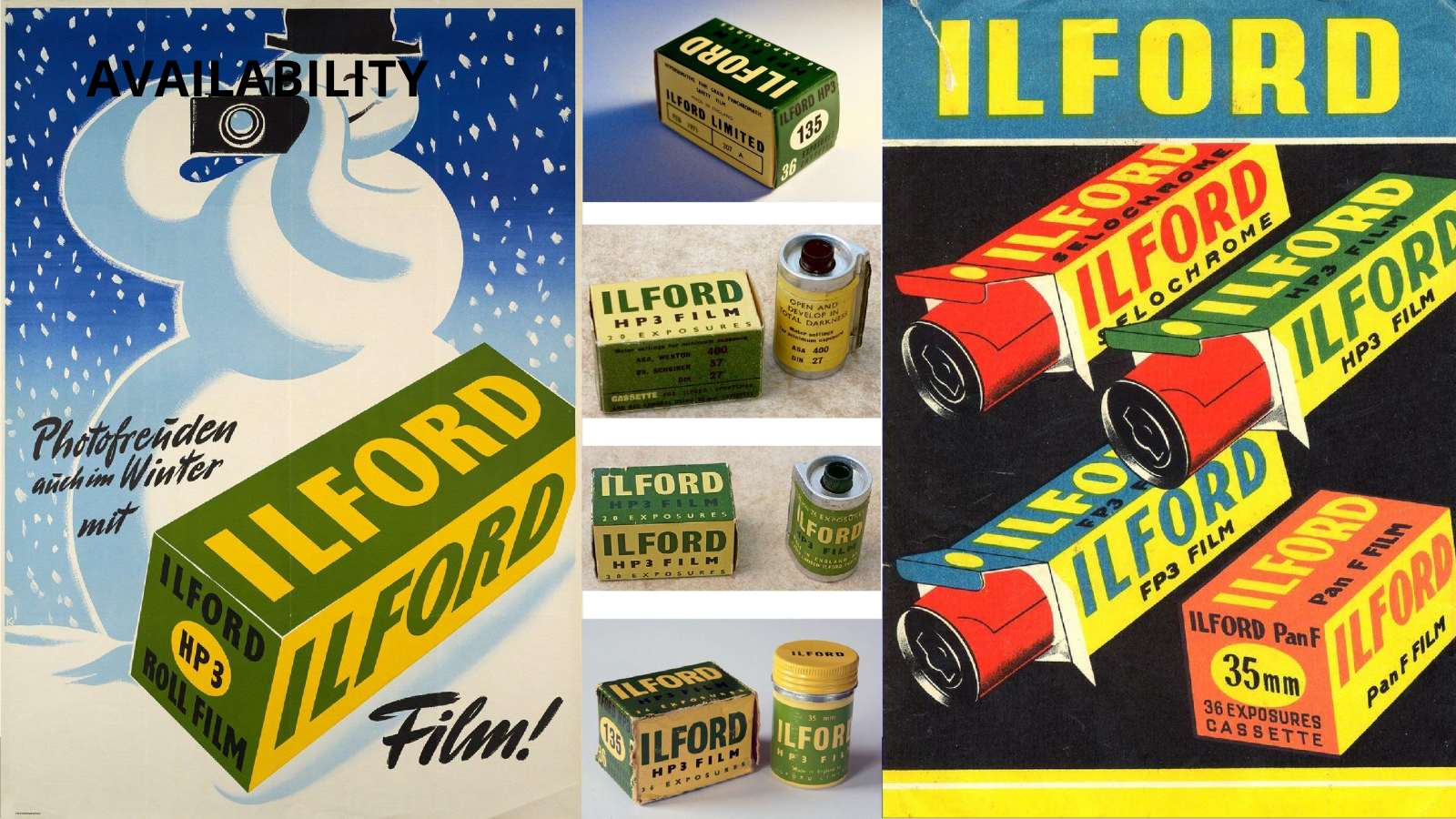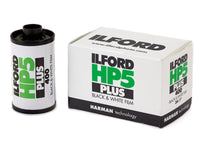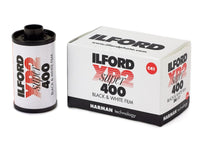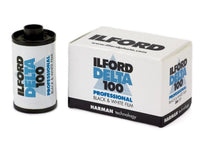Black Friday 2025 has landed at Analogue Wonderland, bringing some of our biggest film photography deals of the year - from discounted film and cameras to money-saving WonderLab processing offers, exclusive bundles, and festive specials available for a limited time only. Grab a great deal while stocks last!
Recent posts

The History of Ilford Film
By Emma Lloyd
This article takes us back to history class but this time we won’t be learning about the Romans or the Tudors, we will be taking a trip back in time and learning about one of the most iconic film brands out there- the history of Ilford film. Ilford is a household name in the film community, a brand that is over 100 years old! I am sure everyone with a film camera has experienced the magic of it (especially the iconic Ilford HP5) and if you haven't done - well now is the time! Let’s find out when the true magic of this legendary brand began by taking a journey through the history of Ilford Film.
Who started Ilford Film?
lford’s story began way way back in the 1800s by Alfred Harman. He was born in 1841 and lived with his family at his photographic studio in Surrey, where four of his children were born. However, this isn’t necessarily the story of a wonderful family business venture like Analogue Wonderland, as Mr Harman suddenly left his wife for another woman and started making photographic plates from his home in Ilford. What a romantic start to Ilford’s story!
Alfred Harman founded the business in 1879 (Ilford recently celebrated the 145 year anniversary with special retro packaging!) and began by making dry plates in the basement of his house in Cranbrook Road, Ilford, Essex. The business was then called 'Britannia Works'.
Photo of Alfred Harman (1841-1913) (c) Ilford Photo
Film through the 1800s- The Early UK Photographic Industry
In 1880 the business grew after the purchase of some houses, which later expanded to a factory that was built adjacent. However, Harman later quarrelled with his agent, Marion's of Soho Square, and lost a lawsuit which then prevented him using the name 'Britannia’ in his products. As a result he announced a change to his products' names and that after February 1886, 'Britannia' plates would henceforth be known as ‘Ilford' plates, after the town in which they traded from.The prices of the dry plates were reduced to penalise the Marion plate company after the dispute with them, a box of one dozen 4 x 5in extra rapid plates cost 10p (2s). Bargain!
Throughout the late 1800s the business continued to expand, now manufacturing Bromide and Alpha paper and a variety of dry plates.
Ilford Alpha Lantern plates, first appeared in 1889 (c) Maurice Fisher photomemorabilia.co.uk
Bromide Platinomatt Surface paper – (‘PMS’ paper). This Bromide Paper was first introduced in 1897 (c) Maurice Fisher photomemorabilia.co.uk
*EDIT* Since writing the blog I have been in contact with Maurice Fisher, the amazing man behind the photomemorabilia website. He has suggested that the dispute between with Marion over the use of the trade mark name Britannia is quite unclear. But he has send me the relevant paragraph from 'Silver by the Ton' to clarify things, see image below.
"It reads to me that, subsequent to having fallen out with Marion & Co for whatever reason, it was Harman who tried to prevent Marion using the Britannia trade mark. Presumably Harman felt the Rights to this name should be entirely his as he had used it for about 6 years. But somehow (unexplained) it seems that Marion had registered their own claim on this trade mark name during the affable times when Harman supplied Marion with Britannia plates for them to sell under their own name. So it was ruled that Marion had a legal Right to continue to use the name Britannia. Maybe Harman had never gotten round to registering the name himself – I just don’t know.
Where this left Harman as regards to his own use of the name Britannia isn’t clearly described, but it caused him to change the trade name of his plates to ‘Ilford’ and bring out the Paddle Steamer trade mark as his company ‘identifier’. His company continued to be known as Britannia Works though changed to Britannia Works Company."
Maurice's website has been a great help to me in writing this blog and I really appreciate his input.
Harman Vs Marion excerpt from Silver by the Ton book, provided to me by Maurice Fisher of photomemorabilia.co.uk
In 1883 Harman introduced the paddle steamer trade mark.
Original version, 1886 Paddle Steamer trade mark. The image went through several adaptations over the years- following slides 1907, 1908, 1911, 1913 (c) Maurice Fisher photomemorabilia.co.uk
In 1890 The Ilford manual of photography was first published, a comprehensive manual of photography which is still in print, now named “The Manual of Photography’. It included technical information about optics, chemistry and printing in far greater depth than any other photographic books out there. Hence it quickly became a staple technical book for the professional and amateur photographer, and is still referred to today. See the preface of the first edition below.
"This handbook has been compiled at the request of the Ilford Company, in the hope that it may be of service to the large numbers of Photographers who apply the art to pictorial, technical, or scientific purposes, and are content to leave to others the preparation of the sensitive materials that they use. It makes no pretence of being a complete treatise on the principles of the art, and it is not written for those for whom the experimental side of Photography has the most attraction. Its aim will be reached if it serves as a trustworthy guide in the actual practice of the art. At the same time, an endeavour has been made to state, in a simple way, sufficient of the principles ..."
The manual is now in its 10th edition, I spoke to some of the film community on twitter who still use some of Ilford's publications to reference to today!
Some Ilford Fans @MorgansPhotogr3 @AgPhotographic @dmbloor
The company was still privately owned at this point and registered as ‘Britannia Works Co. Ltd’ on 17th December 1891. However, they were beginning to see a rise in competition. George Eastman (of Kodak Fame in America) expanded business to a UK premises in 1885, and began manufacturing photographic materials (film and printing papers) until around mid 1891, becoming future competitors of Britannia Works Co. and Ilford. Subsequently “Kodak, Limited” was formed in November 1898. In 1897 and again in 1903, Eastman Kodak approached the company with a view to a take-over or an amalgamation, but nothing came of these propositions. How different the film industry would have looked if this had happened!
The company continued with various publications in the 1800s. This included their magazine Photographic Scraps. This was a free monthly news sheet, originally circulating 5,000 copies per quarterly issue and by July 1893 the monthly issue was over 29,000 copies. The news sheet included updates on the company, their products, fashions and trends in photography and even a photographic glossary. In one issue the magazine refers to the ‘swing back’ in stereoscopic photography and the advantages and disadvantages of the Victorian trend.
Photographic Scraps page 1 of Issue No.44, April 1st, 1893
(c) Maurice Fisher photomemorabilia.co.uk Scans of Photographic Scraps collection Kindly Donated by Doug McKee
Another popular publication was the Ilford Year Book, which appears to be like a Victorian day version of our photographic memo books. It was a small diary-like book that included lots of information, and space for hand written notes about scenes, exposures and plate types used.
These images of the 1895 ILFORD Year Book have been provided by Ron May. Vice President, The Media Factory, Inc (c) Maurice Fisher photomemorabilia.co.uk
Ron says "It is a small 'diary' like book filled with great information and many handwritten notes including scenes/exposures and plate types used etc. filled in by the photographer who originally owned it. It was purchased from a shop in Bradford, UK called J. Walker Photo Store in 1894".
The Year Book consists of 180 pages.
They continued to release a variety of new products, including a variety of plates and printing papers. We can see from the reviews in the photographic scraps magazine that Ilford have stood the test of time of being a reliable photographic brand, see below a customer talking of his experiences working with Ilford products whilst in Trinidad.
Review of Ilford products from customer in Trinidad
Photographic Scraps page 2 of Issue No.44, April 1st, 1893
(c) Maurice Fisher photomemorabilia.co.uk Scans of Photographic Scraps collection Kindly Donated by Doug McKee
Alfred Harman retired from active control of the company at age 50 that time but continued to provide his expertise and experience for several more years.
1900-1940- A Photographic hobby becomes a booming film industry
The 1900s saw a lot of changes and exciting developments to the photographic company. Firstly being that they officially changed their company’s name to one that we know and love today- Ilford! They released their first camera, the Falling Plate magazine cut film camera. The quarter plate ‘box’ camera (although it looks absolutely massive to me!) was advertised as being able to be loaded in less than a minute, which seems a ridiculous selling point nowadays. And it had sufficient film to take 40 exposures before reloading, which is pretty impressive even by today’s standards! Ilford manufactured their own special film with a cardboard backing for the camera. The 1903 & 1904 BJPA gives the price of the camera as £5 with the Bausch & Lomb Rapid Rectilinear f8 lens in Unicum Shutter (T,B, 1-1/100s; as in the NMSI collection) or £8.8s (£8.40p) for the Ross Symmetric Anastigmat lens in Lopa Shutter. Ilford Special Rapid Films, in boxes of 20, cost 3s/4d (16.5p) postage extra. A camera price of £5 is equivalent to around £620 in 2020 money!
The Falling Plate box camera (c) Maurice Fisher photomemorabilia.co.uk
Now believed to be on display at the National Media Museum, Bradford, West Yorkshire, BD1 1NQ (Inventory Number 1976 - 537). It has the Bausch & Lomb lens and Unicum shutter.
(c) Maurice Fisher photomemorabilia.co.uk
1904 advertisement for the Falling Plate camera, taken from the British Journal Photographic Almanac (BJPA)
(c) Maurice Fisher photomemorabilia.co.uk
Alfred Hugh Harman sadly passed away in the 2nd quarter of 1913, but the iconic brand he created lives on. Lots of the brand's development was halted by WWI, where 19 Ilford employees lost their lives serving their country. The photographic scraps magazine also ceased publication in 1914, having reached a monthly circulation of 40,000 copies.
Above is outside the front of the Rajar Building and is dated 13th November 1918 on the back. It is believed it was taken during a peace celebration at the end of WW1.
The company wanted to start producing roll films like 120, which would make film photography much more accessible to the general public. In 1912 an experimental plant was set up in Brentford to make roll film. They introduced their first daylight loading film in 1915 but it was not a success. I can’t find much information on this but loading film in the daylight doesn’t ever sound like a good idea!
In the 1920s, to help with the research and development of roll films, the Selo company was set up by llford, Imperial, Gem and a consortium of seven other UK manufacturers, the consortium eventually took the umbrella name of Amalgamated Photographic Manufacturers (APM). Selo films were sold by these companies under their own brand names. Ilford continued to lead the way in advancing film technology, in 1928 they made their first attempt at manufacturing a subtractive type of negative-positive colour ‘tri-pack’ roll film, called Coloursnap film, however the process proved difficult and was wound up in 1930.
Ilford acquired the Mobberley site (owned by Rajar Ltd since 1903), in the take-over of the various companies within the Selo organisation formed in 1920.
Picture, courtesy of Roger Gittins, showing an artist's impression of the Rajar factory at Mobberley, taken from the British Journal Almanac (BJA) for 1910.
(c) Maurice Fisher photomemorabilia.co.uk
There were further amalgamations and acquisitions to the company including Wellington & Ward, and other old established photographic businesses such as The Imperial Dry Plate Co Ltd, Thomas Illingworth & Co.Ltd and The Gem Dry Plate Co.Ltd. The merging of all these businesses led to Ilford exercising more control over the previously small independents.
Quoting from a Supplement to 'Ilford News' Series 1, Number 6 this was described as a very positive development for all parties,
"The effect of this great merger was a unique pooling of experience, knowledge and craftsmanship. The best brains of the companies concerned became at once concentrated in the research and production of one company's products, with the result that many important new products were produced and improvements effected in various existing grades".
Supplement to 'Ilford News' Series 1, Number 6
(c) Maurice Fisher photomemorabilia.co.uk
In 1935 Ilford began to manufacture a reversal colour film for Dufay-Chromex Ltd. The film had previously only been available in England as 16mm and 9.5 cine film, but with Ilford’s expertise and finance they were able to sell it as 35mm roll film, sheet film and in film pack forms. They also offered a processing service.
How much did colour film developing cost back in the 1930s? Well 120 film for 6 exposures cost 3s/4d (16.5p), over three times the cost of an 8 exposure b&w film and developing (to colour transparencies) cost another 1s/6d (7.5p). Hence, 6 Dufaycolor transparencies cost a total of 4/10d (24p), around £17.42p in 2020 money! When the second world war broke out in 1939, Ilford came under the control of the Ministry of Aircraft Production and it didn’t resume its interest in additive colour post 1945.
To watch a 9minute Dufaycolor film featuring the Selo Film Laboratory, at Brentwood, Essex, click here (catalogue No.6947 of the East Anglian Film Archive within the University of East Anglia ~ UEA)
Dufay Colour Film Envelope - (c) Nicholas Middleton
https://photo-analogue.blogspot.com/2014/12/dufaycolor.html
The 1940s- The Birth of Consumer Film Photography
Ilford continued to lead the way in the 1940s, introducing the world's first true ‘multigrade’ photographic paper.
Ilford Multigrade Paper advertisement from Miniature Camera World, September 1940
(c) Maurice Fisher photomemorabilia.co.uk
An entry in the British Journal Photographic Almanac (BJPA) for 1941 reads
"The revolutionary new Ilford Development Paper 'Multigrade' is, as is now fairly generally known, a material on which the contrast of the print can be varied at will by altering the colour of the printing light.".
The brand continued to introduce lots more films and papers throughout the decade, despite the war. In 1945 the Ilford works were hit in the London Blitz but they endeavoured to continue their work and lectures throughout the war, to keep enthusiasm for photography alive, and they continue to provide amazing educational resources for photography today. Ilford's Lecture Service, which operated throughout the War announced when the war ended "Today, with calm restored, we are more eager then ever to provide the services of our qualified team of lecturers, so if you have a vacant date, drop a line to the Ilford Lecture Service, Ilford Ltd, London."
1940s Ilford Advertisements (c) Stranger's Journey Blog
The signature paddle-steamer trademark, used since 1886, was dropped in 1945 and the new advertising slogan "Ilford films, for Faces and Places" was coined. Prior to this Ilford had used phrases such as "Focus right then gently press: Ilford Selo spells success". This was widely used in newspaper and magazine adverts of the time and certainly during the latter years of the war. It was often partnered with an attractive girl posing provocatively, a camera to her eye, taking a ‘snap’ of her boyfriend or scenic view. I am glad that photography advertising has moved on from this kind of marketing.
Witness camera (c) Live Auctioneers
Ilford released another camera called the witness in 1948. It was a sophisticated 35mm interchangeable lens rangefinder camera, but it was slow to reach the market for various reasons, including a shortage of high quality lenses. However Ilford continued to release a range of cameras.
Another exciting development was the launch of Ilford's colour film, Colour Film "D" 10 ASA, a non substantive reversal film. Ilford tried hard to break into the world for colour film but found a lot of the processes were patented by other leading film manufacturers such as Kodak. They did continue to release cameras throughout the 40s including the advocate series 1 camera and Ilford craftsman. They also launched an exposure metre and dipped into the industry of Sellotape of all things, which was marketed as a handy darkroom tool! See below:
“Sellotape is a self-adhesive, clear cellulose tape which adheres firmly to almost any surface. It is strong and pliable, and thus suitable for many sealing purposes, and other darkroom and studio uses. Sellotape is supplied in rolls, 8½yds in length by 5/8inch wide, in a metal dispenser which can be carried in the pocket and into which refill rolls can easily be loaded. The top of this container allows the required length of Sellotape to be torn off with either a straight or a saw toothed edge. The price of the dispenser, complete with a roll of Sellotape, is 2s.(10p), plus purchase tax; refill rolls cost 1s.(5p) each, plus purchase tax."
Ilford Colour Film D
(c) Maurice Fisher photomemorabilia.co.uk
The 1950s- Ilford Film goes Global
In the fifties, Ilford went international, setting up a company in Australia, Ilford Australia Pty Ltd. The witness camera finally reached the mass market but only around 350 units were sold, as it couldn’t compete with the newly released Leica M3 and its own mass production issues. They continued to release new films, in 1954 the Ilford HPS roll film was launched as “the fastest film in the world”. It was fast panchromatic, 400 ASA in daylight, 320 ASA in tungsten light. The film speed revision of 1960 raised the speed to 800 ASA. They re-launched their multigrade paper with some improvements and continued to launch a variety of cameras.
The brand was growing in success and becoming a household name in photography. By 1958 ICI acquired 32% of Ilford’s shares and an agreement was made which gave Ilford access to ICI’s film research in the negative positive field and in colour photographic technologies, so they could finally branch out into this field. Ilford completed a new office block and a new paper finishing and distribution centre was built at Mobberley, resulting in a large increase in the workforce.
Multigrade relaunch
(c) Maurice Fisher photomemorabilia.co.uk
The 1960s- Everyone is a film fanatic!
The photography industry was booming in the 1960s, particularly because of the new consumerism post war society! Photography was now a big part of advertisements and modern 60s culture. Photography was much more mainstream, lots of people owned a basic camera such as a box Brownie (made by Kodak) and would take snaps of the holidays in our family events. Photography was fast becoming a popular hobby.
I found this video from the Cameras Galore Event in 1960, Oxford Street London, showing just how popular photography had become!
Ilford put investment into hobbyists rather than just professionals and saw a growing young market. In December 1960 saw the first of a series of Special Amateur Nights, held at Ilford House, Oxford Street, London. Over 1,000 visitors turned up in just over 2hours. These events were continued, hobbyists were promised"Full studio facilities; professional type lighting; expert tuition, and beautiful model girls to photograph - all free of charge!" .
Ilford Colour Film Envelope
(c) Maurice Fisher photomemorabilia.co.uk
In 1960, Ilford introduced the first colour negative film ‘Ilfocolor’, available in 35mm film, 20 exposure cassettes. The company introduced a process paid colour film and the negatives were supplied with a free contact strip of colour prints, making the cycle of photography to developing to final print much easier for consumers increasing its popularity.
They continued to develop their film and paper products, such as the Ilfoprint stabilisation paper and in the 1960s they also saw some changes to the business including a new sunburst logo. In 1969 Ilford share acquisitions by Ciba Ag (a chemical based company) and by 1960 Ciba acquired all of ICI’s shares becoming the owners of Ilford Limited. This improved their product line as they adopted some of CIba’s products and research such as colour reversal printing paper and chemistry. Over the years this developed into a world renowned industry standard for prints from transparencies. Ilford eventually ceased supply of their camera and camera accessories and focused on film, chemistry and printing paper, reducing their workforce to around 550.
Ilford Transparency viewer featuring new logo
(c) Maurice Fisher photomemorabilia.co.uk
In 1966 the Monopolies Commission proposed restrictions on process paid-colour film (non-departmental public body responsible for investigating mergers, markets and other enquiries related to regulated industries under competition law in the United Kingdom) that forced Ilford to reduce their prices and reduced import duties on Kodak products.
FP4
(c) Maurice Fisher photomemorabilia.co.uk
In 1968, Ilford FP4 was introduced “Fine Grain, High Speed, Panchromatic, Backed". It was claimed to give greater acutance with finer grain but retaining the same speed of 125ASA (200ASA when developed in Microphen) and the same price. Wide exposure latitude of 6 stops over and 2 stops under, still producing printable results when developed with a reputable photo lab.
Image from FP4 promotional guide
(c) Maurice Fisher photomemorabilia.co.uk
The last exciting event from Ilford in the 1960s was announced in the Practical Photography magazine, August 1969 reporting "ILFORD ON THE MOON".
"As with all earlier missions, Ilford film will be on board Apollo 11 when it attempts its moon landing. The film to be used will be Ilford G5 and K2 Nuclear Research emulsions produced at the Research Laboratory of Ilford Limited, Ilford, Essex. The job of the film is to measure the radiation exposure of the three astronauts. The film will then be analysed and the number of particle tracks will give an indication of the total radiation to which each astronaut has been exposed".
The 1970s and Ilford Film
The 1970s saw more exciting developments and the release of films that we know and love today. In 1970 Ilford were awarded the Queens Award to Industry. This award started in 1966 and was given to British businesses and other organisations who excel at international trade, innovation, sustainable development or promoting opportunity.
Throughout the decade Ilford launched a number of new products including much improved multigrade papers with 11 filters and the iconic HP5 in 1976, it was launched at Photokina. Initially there was a world shortage of this admirable product. The first batches of HP5 were exclusively in the 35mm format and were only sold in Germany, a country selected because it was (at that time) the most profitable marketplace. However they did also decide to discontinue Ilford colour film and paper materials except for Cibachrome
They closed the Ilford site and moved to Basildon in 1976 but continued to strive in the industry, and were awared with the Queen's Award for Industry presented to Ilford for the 2nd time on 5th September 1975. The ceremony held at the Mobberley site and award received by Chief Executive & Managing Director Mr T W Parton. The Award recognised Ilford's export sales during 1972-75, which increased by over 50%. In 9 years their export sales value had risen from near £7million to £20million (August 1974).
They continued to focus on films and papers, the last ilford plates ever manufactured was in the 70s but they continued to celebrate their achievements and long history of innovative photographic developments, celebrating their 100 year anniversary in 1979. The book 'Silver by the Ton - A History of Ilford Limited 1879-1979' was published, authored by RJ Hercock and GA Jones, two distinguished Ilford employees. The publishers were McGraw-Hill Book Co (UK) Ltd, Shoppenhangers Rd, Maidenhead, Berks, SL6 2QL; 176 pages illustrated in black & white. The ISBN is 0-07-084525-5. In August 1979 it was priced at £9.95 in hardback
Some Ilford memorabilia from Mary Davis who left Ilford when the Roden Street offices closed on Friday 13th of February 1976 and were relocated in Basildon.
(c) Maurice Fisher photomemorabilia.co.uk
The 1980s-1990s
This era saw lots of modern advancements as the digital age loomed on the horizon. Nevertheless, Ilford continued to launch new films such as XP1 in 1980, Chromogenic Film - which later became Ilford XP2. However, it was also a difficult time for the business as the price of silver rocketed. The Ilford group restructured due to financial losses, the Practical Photography magazine for May 1980 carried a report on the spiralling cost of silver in their 'Gossip Column'. They wrote that "Ilford is just one of the companies looking for ways of using silver more economically and of recovering silver from scrap films and off-cuts. ......the January 1979 price for silver was £3 an ounce (28.3grams); in January 1980 it was £23 an ounce."
In 1983, Ilford HQ moved to Mobberley Cheshire, where their site is still based to day. Multigrade paper was made available in fibre based paper, producing exceptional quality prints.
Example of results obtainable from Cibachrome II, introduced in 1981
(c) Maurice Fisher photomemorabilia.co.uk
Ilford return to the world of colour films (which they abandoned at the start of 1969) with the re-introduction of an Ilfochrome colour slide film, named Ifochrome 100. An E6 process compatible film, priced £1.60 for a 20exp 35mm and £2.08 for a 36exposure. An Ilfochrome RP6 500cc processing kit (suitable for all E6 reversal films) was priced at £6.25, sufficient to process eight 24exp or five 36exp films. There is suspicion that this film was being sourced from Konica in Japan. They continue to dip into the world of colour film throughout the eighties and nineties with Ilfocolor HR colour print film, but their focus always seems to be with their black and white films and dark room technology.
In 1989 Ilford was sold to the International Paper Corporation of America, this was a time when black and white photography, a branch of photography which Ilgord were and remain product specialists, became recognised and marketed as an art form in its own right. The Ilford brand was re-marketed in this way, putting the focus on photographers and artists with the slogan "Nobody Sees More Into Black & White Than We Do".
Image from marketing campaign after rebrand
(c) Maurice Fisher photomemorabilia.co.uk
Ilford introduced HP5 plus film in 1989 and continued to develop their black and white film range.
In the nineties film photography was at its peak. The excitement surrounding advancements in technology combined with an explosion in consumerism and the mass market resulted in some of the most capable film cameras ever made, a lot of the popular point and shoot cameras we see available today are 90s babies. Ilford took advantage of this surge before the digital age took over and introduced several films: FP4 plus, their first delta film based on core-shell crystal technology, XP2 replaced XP1, Pan F plus launched, Delta 100 was added to the range and there were improved delta professional films as well as an improved range of printing papers.
In 1998 Ilford was acquired by Doughty Hanson under a new name Ilford Imaging Co.
The Noughties- Film on the Decline
The revolution of digital technologies meant that the desire for film declined, but Ilford continued to launch quality products. It was a difficult time for the film industry and many loved brands didn’t make it, Ilford had to cut almost half the jobs at Ilford's Mobberley plant in an attempt to save the company. In 2005 Ilford were saved from closure in a management buy out- HARMAN technology Limited trading as ILFORD PHOTO based at Mobberley, Cheshire, England, focusing on monochrome products. There was still a big decline in interest in analogue photography, with other brands such as Kodak deciding to drop their black and white paper ranges. However, Ilford continued and introduced, Cooltone and Warmtone Developers, new papers and plates and even some pin hole and single use cameras were re-introduced. Introduced. In 2007 HARMAN technology Limited acquires Kentmere Photographic Limited and then in 2015 HARMAN technology/ILFORD PHOTO was purchased by Pemberstone Ventures Ltd.
Today and The future of Ilford Films
Ilford is still a huge name in film photography and are leading the way in photographic education and dark room products. Their website is a treasure trove of information and resources on analogue photography. I personally started my at home darkroom journey with the Ilford simplicity kit and I love it! It comes with everything you need to start processing film at home, with pre-measured sachets of the chemistry so there is no maths or ratio calculations involve, making it perfect for beginners or people like me who just hate maths.
They continue to be one of the most popular brands we sell with a range of quality and reliable products. They continue to launch new innovations in film such as the Ortho 80 film and even re-launching some homages to their previous ventures in cameras like the new Ilford sprite re-usable camera.
I had the pleasure of speaking to Michelle Parr from Ilford, who is the digital marketing specialist there. Michelle gave us an insight into life working at Ilford and shared some photos of the Ilford darkrooms and some memorabilia. Michelle runs the Ilford twitter account and is very active on there, from the Photographic Scraps magazine in the 1800s to tweeting with the film community in 2021, Ilford has come a long way but always kept a strong connection with its customers and fellow film fanatics.
Ilford memorabilia from Michelle Parr at Ilford
As for working here, and especially in the role that I do where I get to chat with the film community every day, I guess that I’m lucky as I get to do something that I’m passionate about. I love film photography and darkroom printing and really enjoy sharing that with my friends (often to their annoyance) and family. I had the kids in the garden last week making sun prints and pinholes and seeing their wonder and enthusiasm is amazing. I still feel it myself every time I make a print!"
Ilford darkroom from Michelle Parr at Ilford
The Ilford Site today! Images from Michelle Parr at Ilford
We hope you have enjoyed this trip back in time looking at the history of Ilford film. It is truly an amazing accomplishment to have survived two world wars, the digital age and now a global pandemic and still be such a thriving film company that is invested in the future of film. For even more juicy details on Ilford's history please see www.photomemorabilia.co.uk for an in-depth look at Ilford's history.
And if this has inspired you to shoot Ilford film then head here for the full range:
Ready to dive in?
Keep Reading
View all
Christmas 2025: Shipping & Opening Hours
Christmas 2025 is fast approaching! To make sure your analogue goodies arrive in time, take note of our last shipping dates, plus opening and operating hours over the festive season. We've got everything you need to gift the magic of film photography this Christmas!

Film Photography Christmas Gift Guide 2025: Analogue Wonderland
Capture the magic of Christmas with film - no filters needed. Our 2025 Film Photography Christmas Gift Guide 2025 is packed with thoughtful presents for every type of shooter, from curious beginners to seasoned photographers. Discover film stocks, cameras, and creative accessories that will make this festive season truly memorable.
Subscribe to our newsletter 💌
Sign up for our newsletter to stay up to date on film photography news, sales and events:
Free Tracked Shipping
On all UK orders over £50
Passion For Film
An unbeatable range and an on-site lab
Our Customers Trust Us
Thousands of independent 5* reviews
All Deliveries are Carbon Neutral
Independently audited and verified by Planet
- Opens in a new window.







